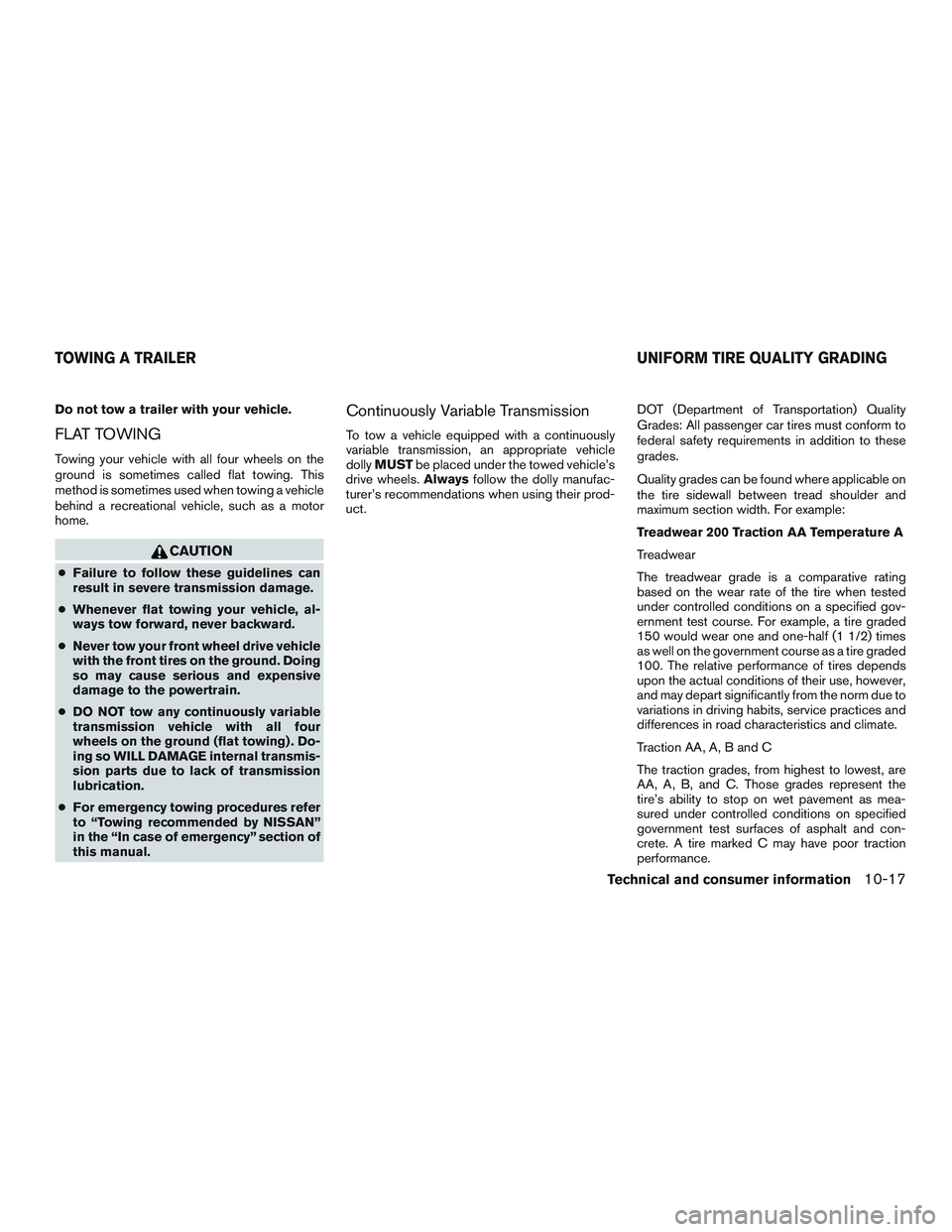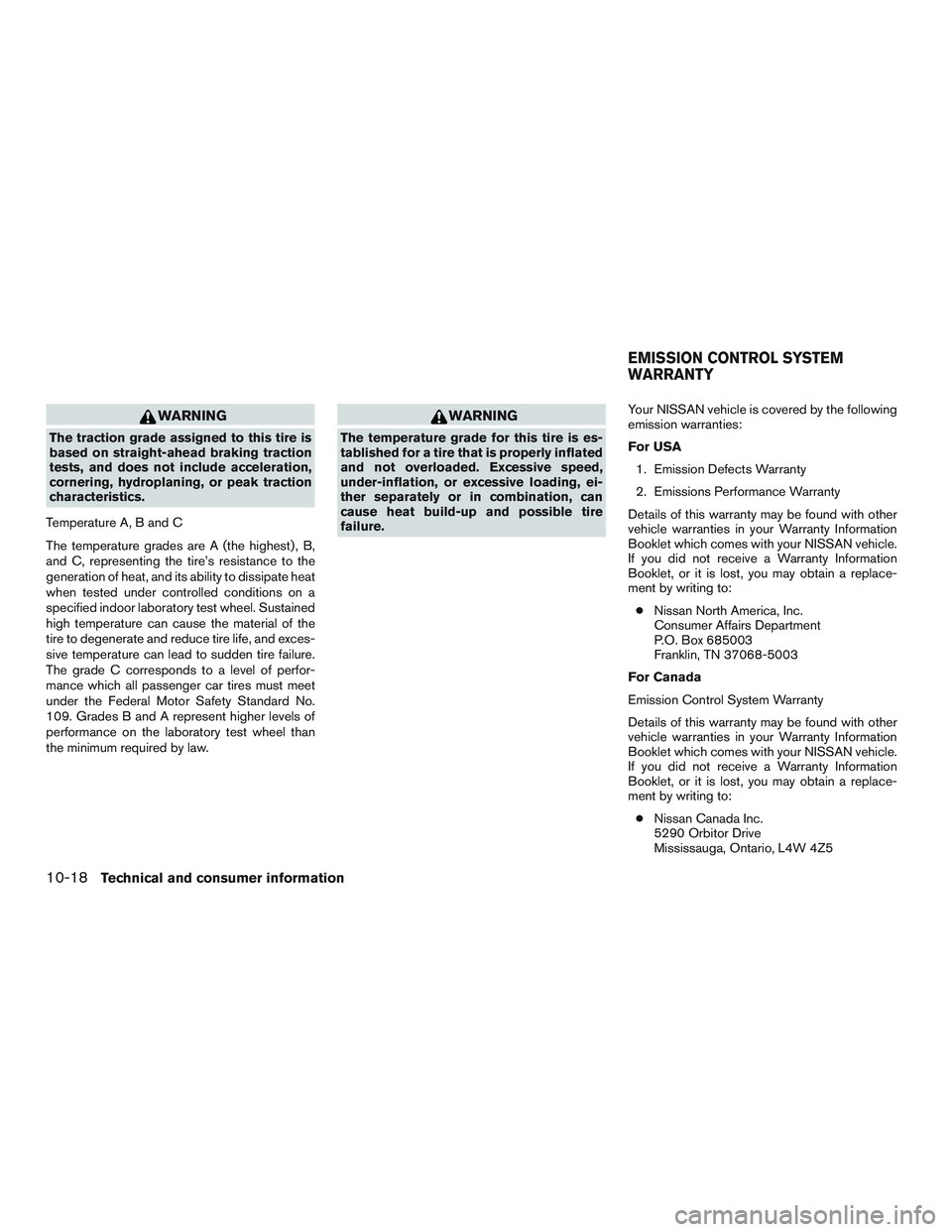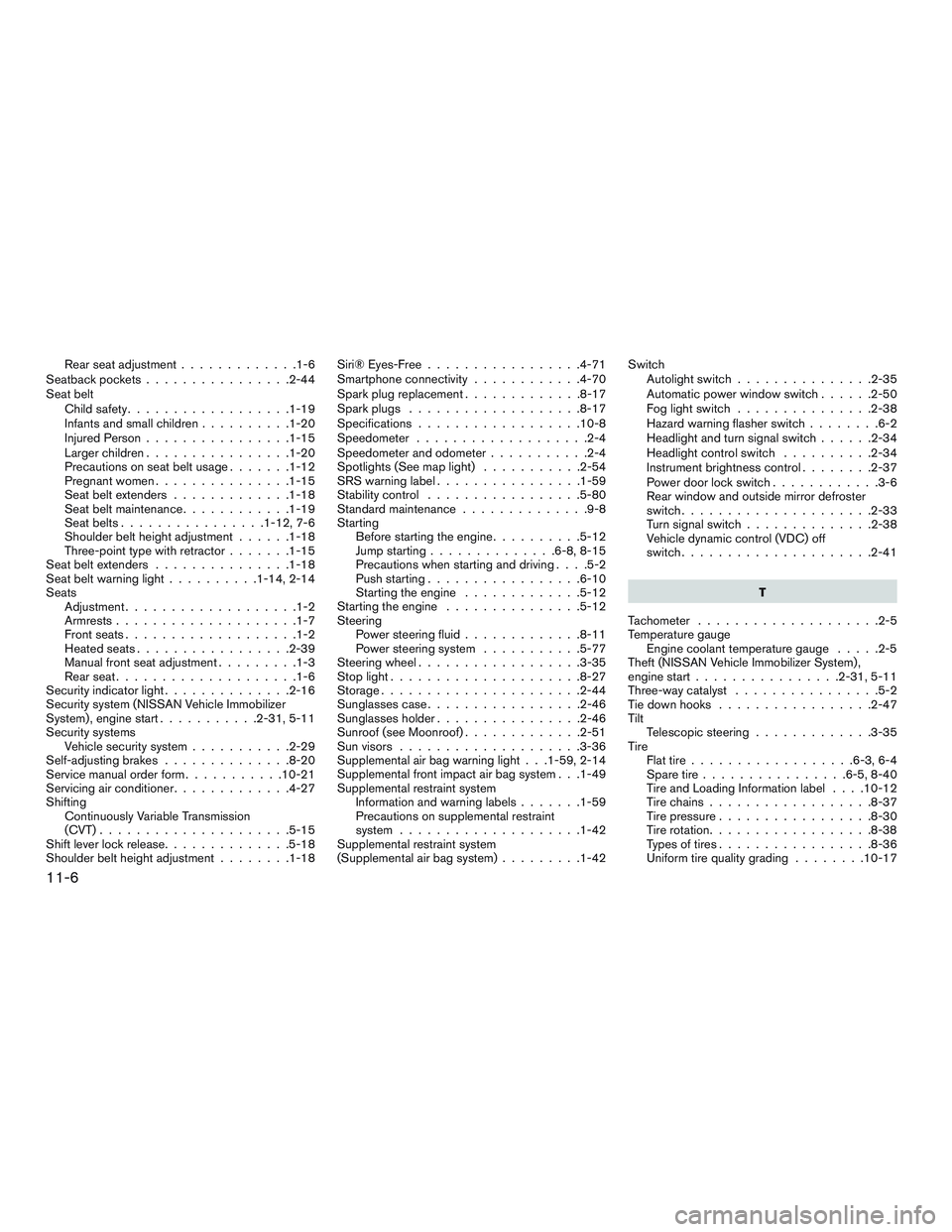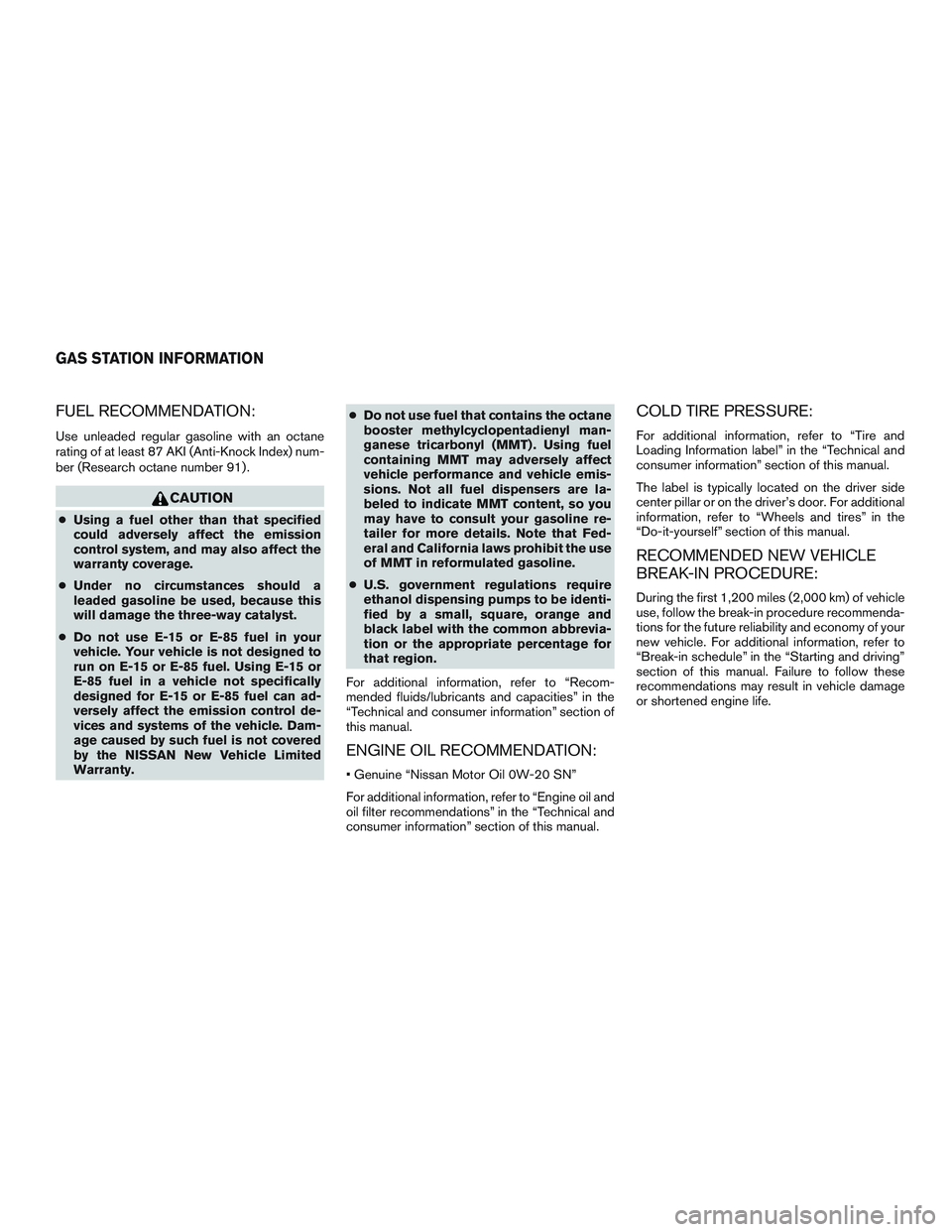2017 NISSAN ALTIMA SEDAN tires
[x] Cancel search: tiresPage 482 of 497

Do not tow a trailer with your vehicle.
FLAT TOWING
Towing your vehicle with all four wheels on the
ground is sometimes called flat towing. This
method is sometimes used when towing a vehicle
behind a recreational vehicle, such as a motor
home.
CAUTION
●Failure to follow these guidelines can
result in severe transmission damage.
● Whenever flat towing your vehicle, al-
ways tow forward, never backward.
● Never tow your front wheel drive vehicle
with the front tires on the ground. Doing
so may cause serious and expensive
damage to the powertrain.
● DO NOT tow any continuously variable
transmission vehicle with all four
wheels on the ground (flat towing) . Do-
ing so WILL DAMAGE internal transmis-
sion parts due to lack of transmission
lubrication.
● For emergency towing procedures refer
to “Towing recommended by NISSAN”
in the “In case of emergency” section of
this manual.
Continuously Variable Transmission
To tow a vehicle equipped with a continuously
variable transmission, an appropriate vehicle
dolly MUST be placed under the towed vehicle’s
drive wheels. Alwaysfollow the dolly manufac-
turer’s recommendations when using their prod-
uct. DOT (Department of Transportation) Quality
Grades: All passenger car tires must conform to
federal safety requirements in addition to these
grades.
Quality grades can be found where applicable on
the tire sidewall between tread shoulder and
maximum section width. For example:
Treadwear 200 Traction AA Temperature A
Treadwear
The treadwear grade is a comparative rating
based on the wear rate of the tire when tested
under controlled conditions on a specified gov-
ernment test course. For example, a tire graded
150 would wear one and one-half (1 1/2) times
as well on the government course as a tire graded
100. The relative performance of tires depends
upon the actual conditions of their use, however,
and may depart significantly from the norm due to
variations in driving habits, service practices and
differences in road characteristics and climate.
Traction AA, A, B and C
The traction grades, from highest to lowest, are
AA, A, B, and C. Those grades represent the
tire’s ability to stop on wet pavement as mea-
sured under controlled conditions on specified
government test surfaces of asphalt and con-
crete. A tire marked C may have poor traction
performance.
TOWING A TRAILER
UNIFORM TIRE QUALITY GRADING
Technical and consumer information10-17
Page 483 of 497

WARNING
The traction grade assigned to this tire is
based on straight-ahead braking traction
tests, and does not include acceleration,
cornering, hydroplaning, or peak traction
characteristics.
Temperature A, B and C
The temperature grades are A (the highest) , B,
and C, representing the tire’s resistance to the
generation of heat, and its ability to dissipate heat
when tested under controlled conditions on a
specified indoor laboratory test wheel. Sustained
high temperature can cause the material of the
tire to degenerate and reduce tire life, and exces-
sive temperature can lead to sudden tire failure.
The grade C corresponds to a level of perfor-
mance which all passenger car tires must meet
under the Federal Motor Safety Standard No.
109. Grades B and A represent higher levels of
performance on the laboratory test wheel than
the minimum required by law.
WARNING
The temperature grade for this tire is es-
tablished for a tire that is properly inflated
and not overloaded. Excessive speed,
under-inflation, or excessive loading, ei-
ther separately or in combination, can
cause heat build-up and possible tire
failure. Your NISSAN vehicle is covered by the following
emission warranties:
For USA
1. Emission Defects Warranty
2. Emissions Performance Warranty
Details of this warranty may be found with other
vehicle warranties in your Warranty Information
Booklet which comes with your NISSAN vehicle.
If you did not receive a Warranty Information
Booklet, or it is lost, you may obtain a replace-
ment by writing to: ● Nissan North America, Inc.
Consumer Affairs Department
P.O. Box 685003
Franklin, TN 37068-5003
For Canada
Emission Control System Warranty
Details of this warranty may be found with other
vehicle warranties in your Warranty Information
Booklet which comes with your NISSAN vehicle.
If you did not receive a Warranty Information
Booklet, or it is lost, you may obtain a replace-
ment by writing to: ● Nissan Canada Inc.
5290 Orbitor Drive
Mississauga, Ontario, L4W 4Z5
EMISSION CONTROL SYSTEM
WARRANTY
10-18Technical and consumer information
Page 493 of 497

Rear seat adjustment.............1-6
Seatback pockets ................2-44
Seat belt Childsafety..................1-19
Infantsandsmallchildren..........1-20
Injured Person ................1-15
Largerchildren................1-20
Precautionsonseatbeltusage.......1-12
Pregnant women ...............1-15
Seat belt extenders .............1-18
Seat belt maintenance ............1-19
Seat belts ................1-12,7-6
Shoulder belt height adjustment ......1-18
Three-point type with retractor .......1-15
Seat belt extenders ...............1-18
Seatbeltwarninglight..........1-14,2-14
Seats Adjustment ...................1-2
Armrests....................1-7
Frontseats...................1-2
Heatedseats.................2-39
Manual front seat adjustment .........1-3
Rear seat ....................1-6
Security indicator light ..............2-16
Security system (NISSAN Vehicle Immobilizer
System) , engine start ...........2-31,5-11
Security systems Vehicle security system ...........2-29
Self-adjusting brakes ..............8-20
Service manual order form ...........10-21
Servicing air conditioner .............4-27
Shifting Continuously Variable Transmission
(CVT) .....................5-15
Shift lever lock release..............5-18
Shoulder belt height adjustment ........1-18Siri® Eyes-Free
.................4-71
Smartphone connectivity ............4-70
Sparkplugreplacement.............8-17
Sparkplugs ...................8-17
Specifications ..................10-8
Speedometer ...................2-4
Speedometer and odometer ...........2-4
Spotlights(Seemaplight) ...........2-54
SRSwarninglabel................1-59
Stability control .................5-80
Standard maintenance ..............9-8
Starting Before starting the engine ..........5-12
Jump starting ..............6-8,8-15
Precautions when starting and driving ....5-2
Push starting .................6-10
Starting the engine .............5-12
Starting the engine ...............5-12
Steering Power steering fluid .............8-11
Power steering system ...........5-77
Steeringwheel..................3-35
Stoplight.....................8-27
Storage......................2-44
Sunglassescase.................2-46
Sunglassesholder................2-46
Sunroof(seeMoonroof).............2-51
Sun visors ....................3-36
Supplemental air bag warning light . . .1-59, 2-14
Supplemental front impact air bag system . . .1-49
Supplemental restraint system Information and warning labels .......1-59
Precautions on supplemental restraint
system ....................1-42
Supplemental restraint system
(Supplemental air bag system) .........1-42Switch
Autolightswitch...............2-35
Automatic power window switch ......2-50
Fog light switch ...............2-38
Hazard warning flasher switch ........6-2
Headlightandturnsignalswitch......2-34
Headlight control switch ..........2-34
Instrument brightness control ........2-37
Power door lock switch ............
3-6
Rear window and outside mirror defroster
switch .....................2-33
Turnsignalswitch..............2-38
Vehicle dynamic control (VDC) off
switch .....................2-41
T
Tachometer ....................2-5
Temperature gauge Engine coolant temperature gauge .....2-5
Theft (NISSAN Vehicle Immobilizer System) ,
engine start ................2-31,5-11
Three-way catalyst ................5-2
Tie down hooks .................2-47
Tilt Telescopic steering .............3-35
Tire Flat tire ..................6-3,6-4
Spare tire ................6-5,8-40
Tire and Loading Information label ....10-12
Tire chains ..................8-37
Tire pressure .................8-30
Tire rotation..................8-38
Types of tires .................8-36
Uniform tire quality grading ........10-17
11-6
Page 494 of 497

Wheels and tires...............8-30
Wheel/tire size ................10-9
Tire pressure Low tire pressure warning light .......2-12
Tire Pressure Monitoring System
(TPMS) ....................5-3,6-3
Towing Flattowing.................10-17
Trailer towing ................10-17
Towing a trailer .................10-17
Towingyourvehicle............6-11,6-12
Transceiver HomeLink® Universal
Transceiver .......2-55,2-57,2-57,2-58
Transmission Continuously Variable Transmission (CVT)
fluid......................8-11
Driving with Continuously Variable
Transmission (CVT) .............5-13
Transmission shift lever lock release ......5-18
Travel
(See registering a vehicle in another country) .........................10-10
Trip odometer ...................2-4
Troubleshooting guide
(NISSAN voice recognition system) .....4-114
Trunk access through the rear seat ....1-6,3-32
Trunklid......................3-30
Trunk lid lock opener lever ............3-30
Trunklight ....................2-54
Turn signal switch ................2-38
U
Uniform tire quality grading ..........10-17USB interface
...............4-55,4-57
Audio file operation ..........4-56,4-58
V
Vanity mirror ...................3-36
Variable voltage control system .........8-16
Vehicle dimensions and weights ........10-9
Vehicle dynamic control (VDC) off switch . . .2-41
Vehicle dynamic control (VDC) system .....5-80
Vehicle Dynamic Control (VDC) system ....5-80
Vehicle identification ..............10-10
Vehicle identification number (VIN) ......10-10
Vehicle identification number (VIN)
(Chassis number) ...............10-10
Vehicle identification number (VIN) plate . . .10-10
Vehicle immobilizer system ........2-31,5-11
Vehicle loading information ..........10-13
Vehicle recovery .................6-13
Vehicle security system .............2-29
Vehicle security system (NISSAN Vehicle
Immobilizer System) , engine start ....2-31,5-11
Ventilators ....................4-16
Visors.......................3-36
Voice Prompt Interrupt . .4-79, 4-92, 4-93, 4-103
Voice recognition system ...........4-110
W
Warning Airbagwarninglight.........1-59,2-14
Anti-lock brake warning light ........2-11
Battery charge warning light ........2-12Blind Spot Warning (BSW) warning
light......................5-20
Brake warning light
.............2-11
Hazard warning flasher switch ........6-2
Loose fuel cap warning ...........2-27
Low fuel warning light ........2-14,2-27
Low tire pressure warning light .......2-12
Low windshield-washer fluid warning
light......................2-27
Passenger air bag and status light .....1-51
Seat belt warning light ........1-14,2-14
Supplemental air bag warning
light ..................1-59,2-14
TPMS ......................2-4
Vehicle security system ...........2-29
Warning/indicator lights and audible
reminders ...................2-15
Warning labels (for SRS) ..........1-59
Warning/indicator lights and audible
reminders.....................2-15 A
udiblereminders..............2-15
Indicatorlights................2-15
Warning lights ................2-15
Warning lights ..................2-15
Warning lights, indicator lights and audible
reminders.....................2-10
Weights (See dimensions and weights) ....10-9
Wheels and tires .................8-30
Wheel/tire size ..................10-9
When traveling or registering in another
country .....................10-10
Windows .....................2-49
Locking passengers’ windows .......2-50
Power rear windows .............2-50
Power windows ...............2-49
Rear power windows ............2-50
11-7
Page 496 of 497

FUEL RECOMMENDATION:
Use unleaded regular gasoline with an octane
rating of at least 87 AKI (Anti-Knock Index) num-
ber (Research octane number 91) .
CAUTION
●Using a fuel other than that specified
could adversely affect the emission
control system, and may also affect the
warranty coverage.
● Under no circumstances should a
leaded gasoline be used, because this
will damage the three-way catalyst.
● Do not use E-15 or E-85 fuel in your
vehicle. Your vehicle is not designed to
run on E-15 or E-85 fuel. Using E-15 or
E-85 fuel in a vehicle not specifically
designed for E-15 or E-85 fuel can ad-
versely affect the emission control de-
vices and systems of the vehicle. Dam-
age caused by such fuel is not covered
by the NISSAN New Vehicle Limited
Warranty. ●
Do not use fuel that contains the octane
booster methylcyclopentadienyl man-
ganese tricarbonyl (MMT) . Using fuel
containing MMT may adversely affect
vehicle performance and vehicle emis-
sions. Not all fuel dispensers are la-
beled to indicate MMT content, so you
may have to consult your gasoline re-
tailer for more details. Note that Fed-
eral and California laws prohibit the use
of MMT in reformulated gasoline.
● U.S. government regulations require
ethanol dispensing pumps to be identi-
fied by a small, square, orange and
black label with the common abbrevia-
tion or the appropriate percentage for
that region.
For additional information, refer to “Recom-
mended fluids/lubricants and capacities” in the
“Technical and consumer information” section of
this manual.
ENGINE OIL RECOMMENDATION:
• Genuine “Nissan Motor Oil 0W-20 SN”
For additional information, refer to “Engine oil and
oil filter recommendations” in the “Technical and
consumer information” section of this manual.
COLD TIRE PRESSURE:
For additional information, refer to “Tire and
Loading Information label” in the “Technical and
consumer information” section of this manual.
The label is typically located on the driver side
center pillar or on the driver’s door. For additional
information, refer to “Wheels and tires” in the
“Do-it-yourself” section of this manual.
RECOMMENDED NEW VEHICLE
BREAK-IN PROCEDURE:
During the first 1,200 miles (2,000 km) of vehicle
use, follow the break-in procedure recommenda-
tions for the future reliability and economy of your
new vehicle. For additional information, refer to
“Break-in schedule” in the “Starting and driving”
section of this manual. Failure to follow these
recommendations may result in vehicle damage
or shortened engine life.
GAS STATION INFORMATION